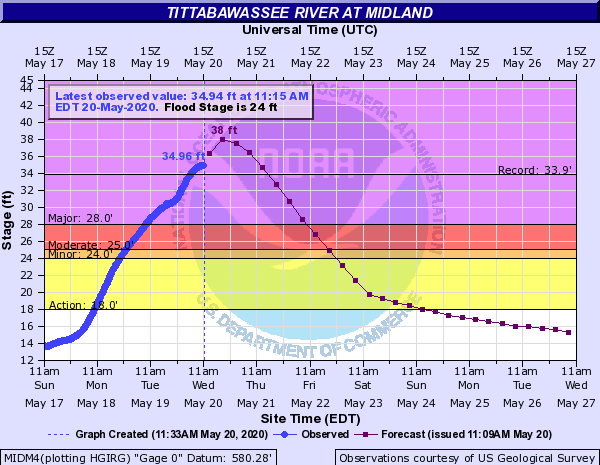
After two dams collapsed under a deluge of stormwater on Tuesday, many residents of Midland, Michigan, have evacuated or are being evacuated.
Michigan Gov. Gretchen Whitmer declared a state of emergency for Midland County on Tuesday after the Edenville and Sanford dams breached.
“If you have not evacuated the area, do so now and get somewhere safe,” Whitmer said. “This is unlike anything we’ve seen in Midland County.”
The Tittabawassee River hit record flood levels following the dam failures. The river, which starts at Secord Lake, flows 36 miles to the Sanford Dam and then another 35 miles from the dam to the Saginaw River, which connects to Lake Huron by Saginaw Bay.
According to the National Weather Service, as of 10 a.m. on Wednesday the river level has hit 34.9 feet and was still rising. Flood stage for the river is 24 feet.

Tittabawassee River water levels (National Weather Service with U.S. Geological Survey data)
The flood warning continues for Tittabawassee River from Midland to Saginaw from “now until further notice.”
On Wednesday morning the Poseyville Dyke broke as well, prompting more evacuations in Midland County, Midland Daily News reported.
One ticking time bomb among many
While unprecedented, this incident doesn’t come out of nowhere. The dams in question were subject to numerous violations and citations as far back as 1999, The Detroit News reported.
The Federal Energy Regulatory Commission revoked the Edenville Dam’s power generation license in September 2018, after citing the owner’s “longstanding failure to address the project’s inadequate spillway capacity at this high hazard dam.”
The issues with the Edenville and Sanford dams aren’t unique either.
The AP reported in November 2019 after a two-year investigation that “1,688 high-hazard dams rated in poor or unsatisfactory condition as of last year in 44 states and Puerto Rico” with some states declining to provide condition ratings for their dams and some having incomplete data due to lack of funding, staffing or authority.
The Edenville Dam was rated a high hazard dam in unsatisfactory condition by the state and is 3 years overdue its state inspection requirement in 2018, according to the AP report.
These dams are put even more at risk when combined with climate change: increasingly heavy and more frequent storm events, which overwhelm the capacity of these dams and other infrastructure such as sewer systems.
In Chicago, the Metropolitan Water Reclamation District of Greater Chicago reversed the flow of the Chicago River into Lake Michigan to cope with the stormwater and rising water levels.
API key not valid. Please pass a valid API key.The Fourth National Climate Assessment, released by U.S. Global Change Research Program in 2017, noted that “the frequency and intensity of heavy precipitation events are projected to continue to increase over the 21st century.”
Already the heavy snows and rainfalls have been affecting Great Lakes water levels, resulting in a number of issues including shoreline erosion and waterfront flooding. In 2019, lakes Superior, Erie and St. Clair hit new records for highest recorded monthly mean for water level, according to the Army Corps of Engineers.
API key not valid. Please pass a valid API key.On May 18, the National Weather Service warned about the upcoming rainfall, tweeting “Heavy rain is going to be a common theme in the coming days for the Midwest and Appalachians. 5-7 inches of rain could fall and create significant flash flooding issues.”
In September 2019, the Mary Griggs Burke Center for Freshwater Innovation published a white paper about Lake Superior water issues, including increasingly intense and frequent storm events.
In June 2012 Duluth was hit by a 500-year storm, followed by 1,000-year storms in both July 2016 and June 2018. The three extreme storm events led to property damage, overflows, overwhelming nutrient runoffs and even deaths.
“We can’t really do anything about the events but what we can do is make sure we’re adapting our infrastructure to be more resilient if these things happen,” Valerie Damstra, operations manager of the Mary Griggs Burke Center for Freshwater Innovation, told Great Lakes Now last year.
API key not valid. Please pass a valid API key.Catch up with Great Lakes Now’s coverage of COVID-19:
State Struggle: Budget shortfalls stall Asian carp plan, put cleanups at risk
Sewage Check: Great Lakes researchers look to wastewater for data on COVID-19
Four environmental issues in the Pittsburgh region to keep your eyes on in the age of COVID-19
Featured image: Water floods the Midland Area Farmers Market and the bridge along the Tittabawassee River in Midland, Mich. on Tuesday, May 19, 2020. (Kaytie Boomer/MLive.com/The Bay City Times via AP)




